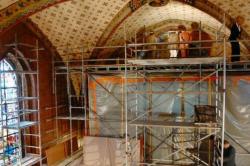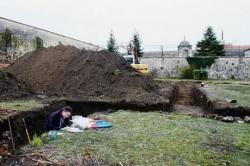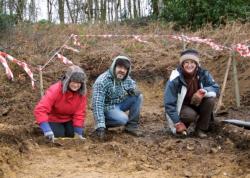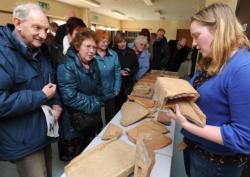30 JANVIER
INDI-UNI : ANTHROPOLOGY - ARCHAEOLOGY
INSCRIPTION 2012 COURS A DISTANCE
REGISTRATION 2012 ONLINE COURSES
AUSTRALIE –  Tasmanie - A dozen archaeology students had no way of knowing if they had half a gallows, or three-quarters of a gallows yesterday. The 2m wide oblong of stone-block foundation marks the place where, on January 31, 1860, John Vigors was executed for "shooting at one John Baker with intent to kill and murder him". But the length of the the platform, through which Vigors and four other men dropped, remains a mystery because the far end lies beneath the Oatlands swimming pool. In the early 1850s the gallows were relocated from the front of the gaol, where 14 others had been executed, to comply with the Private Execution Act, which abolished public hangings. Vigors was the last man executed in Oatlands. The 1837-built jail was the largest regional jail in Van Diemen's Land and was capable of holding 280 people but the most it ever held was only about 100.
Tasmanie - A dozen archaeology students had no way of knowing if they had half a gallows, or three-quarters of a gallows yesterday. The 2m wide oblong of stone-block foundation marks the place where, on January 31, 1860, John Vigors was executed for "shooting at one John Baker with intent to kill and murder him". But the length of the the platform, through which Vigors and four other men dropped, remains a mystery because the far end lies beneath the Oatlands swimming pool. In the early 1850s the gallows were relocated from the front of the gaol, where 14 others had been executed, to comply with the Private Execution Act, which abolished public hangings. Vigors was the last man executed in Oatlands. The 1837-built jail was the largest regional jail in Van Diemen's Land and was capable of holding 280 people but the most it ever held was only about 100.
http://www.themercury.com.au/article/2012/01/31/296771_tasmania-news.html
FRANCE – Aire sur l'Adour - La rénovation de l'intérieur de la cathédrale aturine achevée, les travaux se poursuivront en 2013 par la réfection du parvis puis, dans un second temps, dans le cloître situé derrière le mur de droite de la cathédrale. Mais avant que ces chantiers ne soient entrepris, des fouilles archéologiques programmées par la Drac et effectuées par l'Inrap ont débuté. Parmi les trouvailles qui n'ont pas suscité d'étonnement, on citera des ossements en plusieurs endroits. Rien d'anormal à cela puisque des cimetières étaient souvent disposés aux alentours immédiats des édifices religieux. Les archéologues ont également mis à jour le mur sud de la troisième travée de la cathédrale qui a été amputée de cette partie au XIVe siècle. Si ces premières trouvailles étaient prévisibles, les fouilles ont mis à nu d'autres choses qui correspondent à des périodes plus anciennes. Pour la première fois, des témoignages de l'occupation de la période antique ont été dévoilés. « Nous avons découvert un mur et des pilettes qui laisseraient penser qu'à cet endroit était édifiée une villa particulière appartenant à une riche personne ou des thermes. Ces pilettes, petits piliers de briques, permettaient de laisser passer l'air chaud produit par un puissant foyer situé à l'extérieur de la maison », explique Gilberte Pandard, adjointe au maire, en charge des affaires culturelles. En résumé, le chauffage hypocauste peut être considéré comme un cousin très éloigné de notre plancher chauffant. Les fouilles à l'intérieur du cloître semblent aussi être pleines de promesses. On vient d'y retrouver les strates de l'histoire de la ville depuis le Haut Empire. Toutes ces trouvailles vont être inventoriées avant que les travaux de réfection du parvis et du cloître ne débutent. Avec pour objectif de rendre au public l'entrée dans le cloître qui mènera à la salle du Trésor qui prendra place dans l'actuelle salle capitulaire du XIVe siècle.
Aire sur l'Adour - La rénovation de l'intérieur de la cathédrale aturine achevée, les travaux se poursuivront en 2013 par la réfection du parvis puis, dans un second temps, dans le cloître situé derrière le mur de droite de la cathédrale. Mais avant que ces chantiers ne soient entrepris, des fouilles archéologiques programmées par la Drac et effectuées par l'Inrap ont débuté. Parmi les trouvailles qui n'ont pas suscité d'étonnement, on citera des ossements en plusieurs endroits. Rien d'anormal à cela puisque des cimetières étaient souvent disposés aux alentours immédiats des édifices religieux. Les archéologues ont également mis à jour le mur sud de la troisième travée de la cathédrale qui a été amputée de cette partie au XIVe siècle. Si ces premières trouvailles étaient prévisibles, les fouilles ont mis à nu d'autres choses qui correspondent à des périodes plus anciennes. Pour la première fois, des témoignages de l'occupation de la période antique ont été dévoilés. « Nous avons découvert un mur et des pilettes qui laisseraient penser qu'à cet endroit était édifiée une villa particulière appartenant à une riche personne ou des thermes. Ces pilettes, petits piliers de briques, permettaient de laisser passer l'air chaud produit par un puissant foyer situé à l'extérieur de la maison », explique Gilberte Pandard, adjointe au maire, en charge des affaires culturelles. En résumé, le chauffage hypocauste peut être considéré comme un cousin très éloigné de notre plancher chauffant. Les fouilles à l'intérieur du cloître semblent aussi être pleines de promesses. On vient d'y retrouver les strates de l'histoire de la ville depuis le Haut Empire. Toutes ces trouvailles vont être inventoriées avant que les travaux de réfection du parvis et du cloître ne débutent. Avec pour objectif de rendre au public l'entrée dans le cloître qui mènera à la salle du Trésor qui prendra place dans l'actuelle salle capitulaire du XIVe siècle.
http://www.sudouest.fr/2012/01/30/les-archeologues-menent-des-fouilles-prometteuses-619138-3269.php
FRANCE –  Saintes - Des vestiges d'un château médiéval et de l'époque gallo-romaine de Saintes se cacheraient-ils dans le sous-sol de l'un des jardins de l'Ehpad (Établissement d'hébergement pour personnes âgées dépendantes) La Providence ? C'est ce que laisserait supposer un diagnostic archéologique mené par l'archéologue de l'Inrap (Institut national de recherches Archéologiques préventives) Jean-Philippe Baigl, qui a eu lieu ces derniers jours. Certaines découvertes pourraient même provenir d'un forum gallo-romain qui était alors le cœur commercial, social, administratif, religieux et politique de Mediolanum Santonum, nom donné à Saintes dans l'Antiquité. C'était un espace entouré de colonnades et de portiques où se trouvaient quelques bâtiments administratifs et religieux. Il faudra attendre les conclusions du rapport de l'archéologue et, peut-être, une campagne de fouilles pour le savoir. En tout cas, des murs, des niveaux de circulation, des pièces de monnaie ou encore des morceaux de mosaïque sont apparus. Le diagnostic a été diligenté par la Drac (Direction régionale des affaires culturelles) dans le cadre d'un projet d'extension de la maison de retraite médicalisée située dans les hauteurs de Saintes, esplanade du Capitole.
Saintes - Des vestiges d'un château médiéval et de l'époque gallo-romaine de Saintes se cacheraient-ils dans le sous-sol de l'un des jardins de l'Ehpad (Établissement d'hébergement pour personnes âgées dépendantes) La Providence ? C'est ce que laisserait supposer un diagnostic archéologique mené par l'archéologue de l'Inrap (Institut national de recherches Archéologiques préventives) Jean-Philippe Baigl, qui a eu lieu ces derniers jours. Certaines découvertes pourraient même provenir d'un forum gallo-romain qui était alors le cœur commercial, social, administratif, religieux et politique de Mediolanum Santonum, nom donné à Saintes dans l'Antiquité. C'était un espace entouré de colonnades et de portiques où se trouvaient quelques bâtiments administratifs et religieux. Il faudra attendre les conclusions du rapport de l'archéologue et, peut-être, une campagne de fouilles pour le savoir. En tout cas, des murs, des niveaux de circulation, des pièces de monnaie ou encore des morceaux de mosaïque sont apparus. Le diagnostic a été diligenté par la Drac (Direction régionale des affaires culturelles) dans le cadre d'un projet d'extension de la maison de retraite médicalisée située dans les hauteurs de Saintes, esplanade du Capitole.
http://www.sudouest.fr/2012/01/30/des-vestiges-antiques-et-medievaux-dans-le-jardin-619405-1531.php
ROYAUME UNI –  – Yearsley Moor - The Yearsley Moor Archaeological Group has divided itself into pairs to look at different periods of history on the moor. One of them concentrated on the excavation of a rabbit-hole riddled mound, about 50ft in diameter and less than two feet high, which was found in a thickly wooded area of the moor. It is thought to be a Bronze Age barrow, the burial site of a chieftain. Another fascinating discovery traced by group members is a series of bell pits, a primitive method of extracting coal. Short vertical shafts were dug into the moor and then widened to form small chambers in the coal seams. Chris Williams, one of the group, said in a recent video about the Yearsley group’s work: “Would I go onto the moor at night? Probably not, because it has been intimated that you can hear the miners still digging away in the pits, and one must imagine that some pits still retain the bodies of some of those miners.” Much of what is seen on the ground today has been shaped by its use through medieval times as a deer park. The group has even traced the actual licence for this, written in Latin and granted by Edward III in 1374, declaring that 1000 acres of land and woods were granted to Thomas de Etton of Gilling Castle. The original boundaries can still be seen, although all that’s left is a well-pronounced bank with ditches on either side. The fence of oak paling which would have been top has long gone, but around 70 per cent of the bank has been traced by the Yearsley Group.
– Yearsley Moor - The Yearsley Moor Archaeological Group has divided itself into pairs to look at different periods of history on the moor. One of them concentrated on the excavation of a rabbit-hole riddled mound, about 50ft in diameter and less than two feet high, which was found in a thickly wooded area of the moor. It is thought to be a Bronze Age barrow, the burial site of a chieftain. Another fascinating discovery traced by group members is a series of bell pits, a primitive method of extracting coal. Short vertical shafts were dug into the moor and then widened to form small chambers in the coal seams. Chris Williams, one of the group, said in a recent video about the Yearsley group’s work: “Would I go onto the moor at night? Probably not, because it has been intimated that you can hear the miners still digging away in the pits, and one must imagine that some pits still retain the bodies of some of those miners.” Much of what is seen on the ground today has been shaped by its use through medieval times as a deer park. The group has even traced the actual licence for this, written in Latin and granted by Edward III in 1374, declaring that 1000 acres of land and woods were granted to Thomas de Etton of Gilling Castle. The original boundaries can still be seen, although all that’s left is a well-pronounced bank with ditches on either side. The fence of oak paling which would have been top has long gone, but around 70 per cent of the bank has been traced by the Yearsley Group.
http://www.yorkshirepost.co.uk/news/country-view/farming/time_team_of_yearsley_moor_are_digging_up_its_secrets_1_4188953
ROYAUME UNI –  – Peterborough - Artefacts from a stunning Roman villa which was unearthed in Walton, Peterborough went on display at the weekend. The display contained dozens of items found at the site including pottery, jewellery, brooches, tools and wall plaster dating back more than 2,000 years. Alex Pickstone, project officer for Oxford Archaeology, which carried out the dig, said: “We certainly weren’t expecting so many people to come along to the display – it seems to have captured people’s imaginations. “This was a very unique find and we were surprised that the villa and many of the artefacts found were in such a good condition. “We found numerous pieces of pottery including bowls and jugs and many were still in one piece. “It’s difficult to say if there are any more sites like this in the local area. Roman settlements tended to be quite isolated so we’re treating this as a unique discovery.” James Drummond-Murray, project manager for Oxford Archaeology, added: “Underneath the villa was an Iron Age settlement, dating back to 100BC. “It is possible that the villa was built for an Iron Age chief. “The discovery allows us to look at the possible locations of roads and communication networks in the area at the time.”
– Peterborough - Artefacts from a stunning Roman villa which was unearthed in Walton, Peterborough went on display at the weekend. The display contained dozens of items found at the site including pottery, jewellery, brooches, tools and wall plaster dating back more than 2,000 years. Alex Pickstone, project officer for Oxford Archaeology, which carried out the dig, said: “We certainly weren’t expecting so many people to come along to the display – it seems to have captured people’s imaginations. “This was a very unique find and we were surprised that the villa and many of the artefacts found were in such a good condition. “We found numerous pieces of pottery including bowls and jugs and many were still in one piece. “It’s difficult to say if there are any more sites like this in the local area. Roman settlements tended to be quite isolated so we’re treating this as a unique discovery.” James Drummond-Murray, project manager for Oxford Archaeology, added: “Underneath the villa was an Iron Age settlement, dating back to 100BC. “It is possible that the villa was built for an Iron Age chief. “The discovery allows us to look at the possible locations of roads and communication networks in the area at the time.”
http://www.peterboroughtoday.co.uk/news/local/itter_crescent_s_roman_villa_finds_revealed_1_3468138
ROYAUME UNI - Brede High Woods - Budding archaeologists are needed to help uncover the historical secrets hidden at a woodland site near Hastings. The team, led by Chris Butler Archaeological Services, are hoping to find out more about the Brede Furnace, which was previously situated in the area. They are aiming to date charcoal hearths, saw-pits, iron ore pits and other earthworks from the furnace. They will then use historical records to find out who owned the site, manorial customs and how the furnace was managed.
http://www.littlehamptongazette.co.uk/news/regional/call_for_archaeology_volunteers_1_3468915